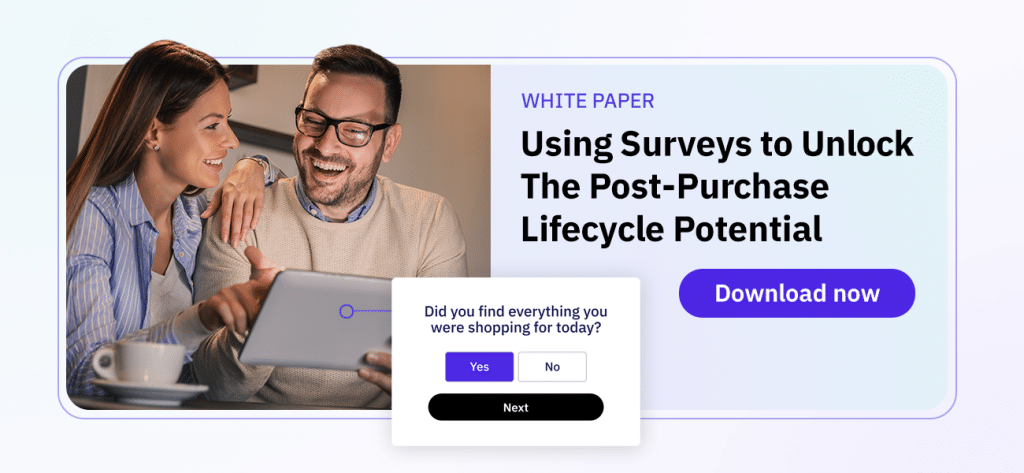
- Customer Experience
12 Ways to Improve Ecommerce Customer Experience
Megan Wenzl | Apr 10, 2024
Jan 24, 2023 | 6 minute read

Lindsay Kolinsky
Director of Marketing
Whether the goal is to increase sales, improve user experiences, or understand the effectiveness of marketing campaigns, online merchants today need the ability to collect and analyze data related to various points in the customer journey.
But as regulators and big tech tighten controls around privacy, businesses now face the additional challenge of adapting their data collection strategies to keep pace with the rapidly evolving digital landscape.
For these reasons, merchants are increasingly looking to cut out the middleman and acquire insights directly from customers through the use of post-purchase surveys. And while the customer survey is not a new concept, traditional approaches often fail to produce the quality of data needed to overcome privacy hurdles and meet the shifting demands and expectations of consumers.

Put simply, the primary challenge is being able to target your surveys to the right customer at the right moment. That’s why so many marketing teams are now looking to bolster their post-purchase survey efforts with a contextual targeting strategy. In this blog, we’ll define contextual targeting, explore how it works, and highlight why targeted surveys could be the missing link to engaging with customers more effectively in the digital age.
Often, when people think of contextual targeting it’s in reference to the method of online advertising that uses contextual information to determine which ads to display on a given web page. For example, if a user is reading an article on health and fitness they might see ads for gym equipment or other relevant products and services. By using data such as past browsing behavior, demographics, purchase history, etc, advertisers can customize their ads to target a specific audience with relevant content. As a result, this data-driven approach increases the likelihood that these ads will convert and lead to sales.
But the impact of contextual targeting can be seen far beyond advertising. In fact, merchants can harness contextual targeting to take a much more prescriptive and effective approach with their post-purchase survey and data collection strategies.
Traditionally, ecommerce teams have treated post-purchase surveys as catch-alls, using basic, one size fits all survey templates that are delivered once a purchase has been completed. And while this might be sufficient if your goal is to collect generalized feedback from any customers willing to engage, it doesn’t do anything to actually maximize engagement and allow you to collect the right data that you need to get actionable insights. Why? Well, think of it this way—if you’re running fitness equipment ads on a webpage talking about running, you probably won’t see many conversions. Similarly, if you’re taking a generalized approach to delivering surveys you probably won’t see much success.
This is where contextual targeting comes in. Rather than relying on a blanket approach, contextual targeting allows merchants to create a set of conditions in order to precisely target specific audiences with the right questions—at the right time—across key touchpoints.
This approach not only minimizes friction associated with the post-purchase survey experience but most importantly it supercharges their ability to collect the actionable insights necessary to build more comprehensive customer profiles and optimize the effectiveness of their marketing campaigns.
Okendo Surveys was designed specifically around the belief that the most successful merchants will continue to focus on optimizing the user experience and building stronger, more sustainable relationships with new and existing customers.
So how is it done? In the simplest sense, Surveys allows merchants to integrate contextual targeting into the post-purchase survey process through precise and customizable triggers and filters that dictate when, where, how often, and to whom micro-surveys are presented.
More specifically, contextual targeting triggers cover an extensive range of specific events and behavioral indicators to determine exactly when a survey should be displayed to audiences, including factors such as:
To determine which specific audience to reach, merchants can utilize filters that feature a wide range of parameters for identifying hyper-specific audience eligibility such as:
Additionally, contextual targeting through Okendo Surveys comes with engagement controls to help dictate how often customers are prompted based on previous activity and other relevant factors. This helps to prevent missteps that can be frustrating to both your team and the customer, such as presenting a “How Did You Hear About Us” (HDYHAU) survey to a repeat customer who has already provided—or opted not to provide—this information after a previous purchase. Or if you’re missing the hair color of a customer in their profile because they didn’t leave a review with that attribute information included, you can trigger a survey that asks “What is your hair color?” so you can complete the customer profile.
Beyond improving customer experiences with onsite post-purchase surveys, Okendo Surveys’ multi-channel flexibility allows you to take things a step further and drive engagement off-site through the delivery of sharable link surveys. For example, if you want to incentivize ongoing engagement with customers who have an average order value (AOV) of more than $500, you can create a segment in Klaviyo or your ESP of choice, and send an Okendo Surveys shareable link with a follow-up survey to their email that includes a discount code or promotional offering in exchange for their participation.
The more your marketing team recognizes the value of adding context and specificity to their targeting efforts, the more success they’ll have in utilizing post-purchase surveys and generating actionable zero-party data, something which is only growing in importance in an age where privacy is the priority. These highly detailed insights give merchants an opportunity to not only overcome evolving data privacy hurdles but to establish mutually beneficial relationships with customers by providing personalized experiences in exchange for their feedback.
It’s hard to overstate the importance of optimizing reporting and analysis in light of evolving regulations and consumer preferences. As such, contextual targeting is becoming a critical tool for gathering the resources needed to make data-backed decisions, and ultimately to establish targeted surveys processes that maximize your ability to elevate your customer experience and scale your business.
Related articles
Ready to learn more?